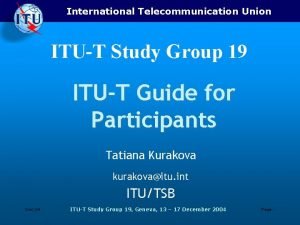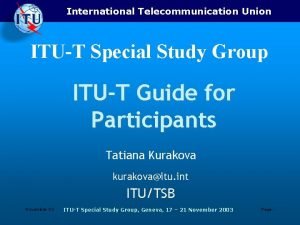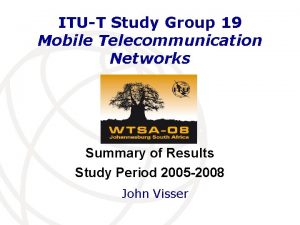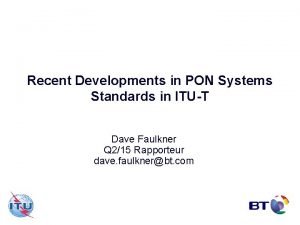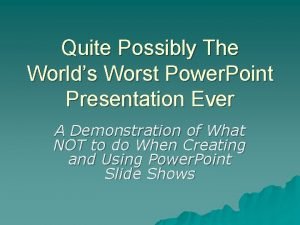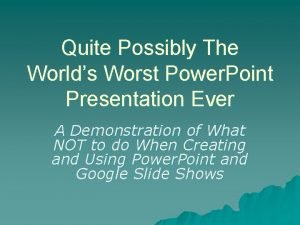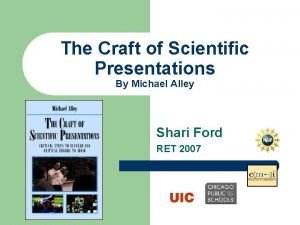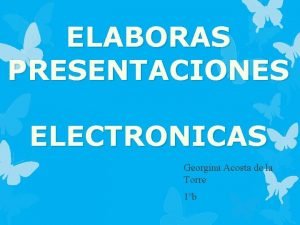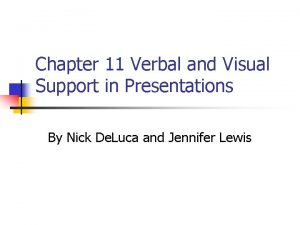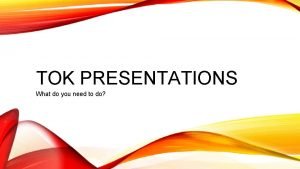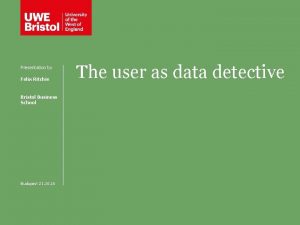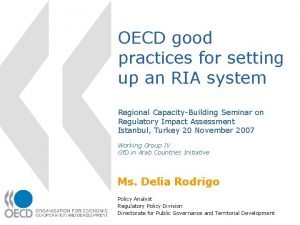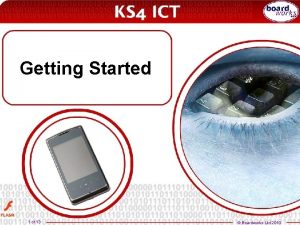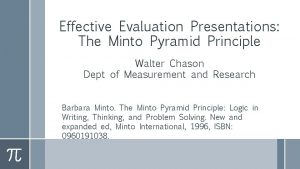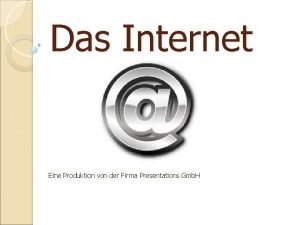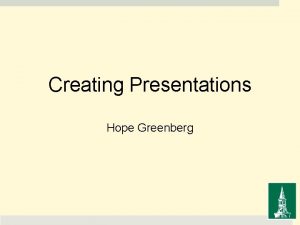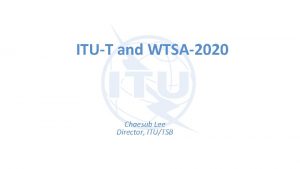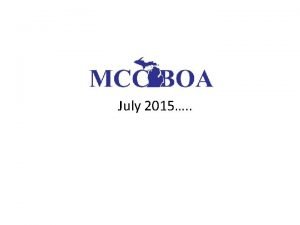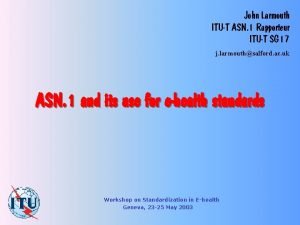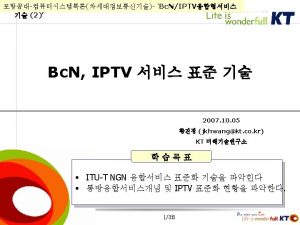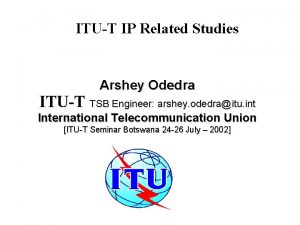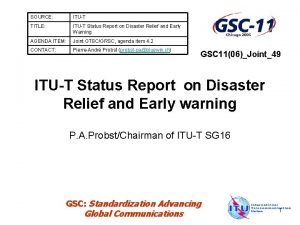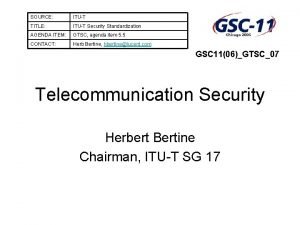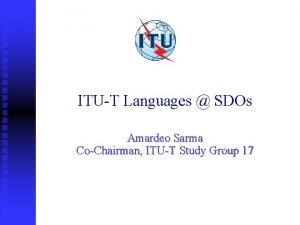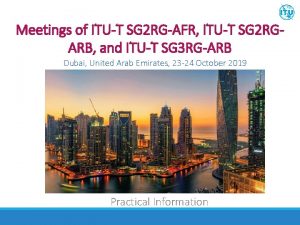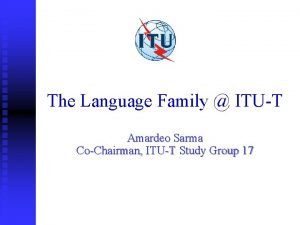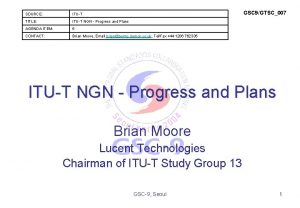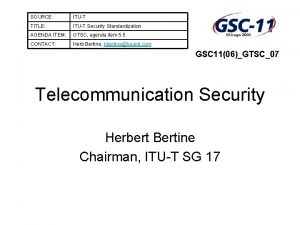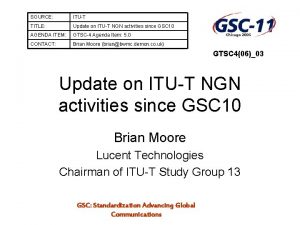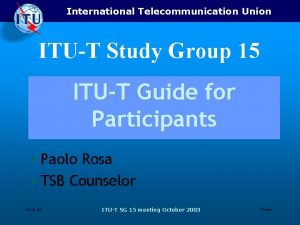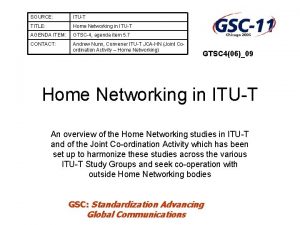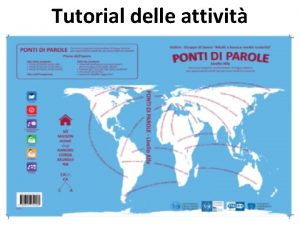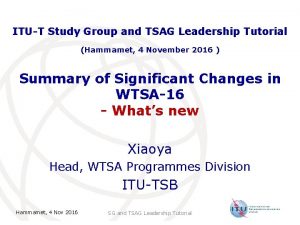ITUT Tutorial and Presentations 2 July 2012 ITUT


























- Slides: 26

ITU-T Tutorial and Presentations 2 July 2012 ITU-T and Smart Grid Dr. Stefano Galli Rapporteur ITU-T Q 4 c/15 – Comms for Smart Grid Co-convenor of JCA on Smart Grid and Home Networking

Outline Introduction to ITU and Smart Grid ITU’s family of PLC recommendations ITU cooperation with other SDOs 2

Introduction to ITU Founded in 1865, oldest specialized UN agency ITU = ITU-T + ITU-R + ITU-D ITU-T: develops ICT standards ITU-R: manages radio spectrum & satellite orbits ITU-D: promotes ICT development Common Patent Policy among ITU/ISO/IEC Basis for the international telecommunications networks, over 3000 standards (Recommendations) Increasingly extending to all aspects of ICTs Strategic objectives (2012 -2015): Coordination and international cooperation Production of global standards Bridging the standardization gap Dissemination of information 3

Efficient Working Methods New work items can be agreed and started at any time, no complex procedures are necessary Work areas (Questions) in each Study Groups are up and running Fast in developing standards From weeks to 2 -3 years Recommendations can be approved very fast Average: 9. 5 weeks Very fast in publishing standards Couple of weeks for pre-published web version after approval A few months for edited version 4

Introduction to ITU and Smart Grid ITU’s family of PLC recommendations ITU cooperation with other SDOs 5

Role of ICT in Smart Grid The fundamental challenge in power grids is to ensure the balance of generation and demand The fundamental challenge in the Smart Grid is to ensure balance of generation and demand when integrating all those new technologies that are aimed at addressing in a sustainable manner energy independence and modernization of the aging power grid: Utility scale Renewable Energy Sources (RES) feeding into the transmission system Distributed Energy Resources (DER) feeding into the distribution system Plug-in (Hybrid) Electric Vehicles (PHEV) Demand Side Management (DSM) Consumer participation Storage to compensate for the time varying nature of some renewables 6

Role of ICT in Smart Grid • • Supporting the above technologies and applications, requires the availability of a modern, flexible, and scalable communications network that ties monitoring and control together The true “key” enabler for the Smart Grid is the availability of a pervasive two-way data communication network across the whole grid, from generation to load Smart grid services & applications Security control and management Information Communication Infrastructure Intelligent grid management Advance metering infrastructure Home automation (appliances, PEV, etc. ) 7

Related work in ITU-T Items SG 15 SG 16 SGs and aspects Service Layer use cases, requirements, APIs and protocols for healthcare and other application Q 3/13 USN, MOC Q 12/13 Ubiquitous networking (object to object communication) Q 1/15 IP home network Q 25/16 USN applications and services SG 15 Q 4 c/15 PHY/DLL aspects of smart metering FG M 2 M (1) M 2 M (2) Smart metering (3) Vehicle communication SG 13 SG 16 Collaboration on ITS Communication Standards http: //www. itu. int/en/ITU-T/extcoop/cits/ Q 12/13 networked vehicle Q 27/16 Vehicle gateway platform for telecommunication/ITS services /applications Q 12/13 Next generation home network Q 1 and Q 2/15 IP home network and access network Qo. S Q 4 a/15 Broadband in-premises networking Q 4 b/15: Home networking related Smart Grid communications Q 21/16 home network services SG 13 Q 21/13 Future network SG 15 Q 4 c/15 Communications for Smart Grid CITS SG 13 SG 16 SG 13 (4) Access and Home networking (5) Energy saving network (6) Smart Grid SG 15 8

Focus Group on Smart Grid When? Established in Feb. 2010, concluded in Dec. 2011 Management Team Title Chairman Vice Chairman TSB Secretariat TSB Assistant Name Mr Les Brown (Lantiq, Germany) Ms Li Haihua (MIIT, China) Mr Hyungsoo Kim (Korea Telecom, Korea) Mr Yoshito Sakurai (Hitachi, Japan) Mr David Su (NIST, USA) Mr Hiroshi Ota Ms Emmanuelle Labare 9

FGSmart - Scope: Identify impacts on standards development Investigate ITU-T study items Familiarize ITU-T with emerging attributes of Smart Grid Encourage collaboration between ITU-T membership and utilities/Smart Grid community Objective: Collect and document information and concepts that would be helpful for developing Recommendations to support Smart Grid from an ICT perspective Web site: http: //www. itu. int/en/ITU-T/focusgroups/smart/ 10

FGSmart - Tasks assigned to the Focus Group to meet this objective include: update living list of standards bodies, forums, and consortia dealing with smart grid identify use cases of smart grid that can be used to derive communication network requirements analyze communication networking requirement functions and capabilities to support smart grid provide terminology/taxonomy necessary to support Smart Grid suggest future ITU-T study items and related actions The complete terms of reference can be found at: http: //www. itu. int/en/ITUT/focusgroups/smart/Pages/tor. aspx 11

FGSmart - Output Concluded in 12/2011, FGSmart produced five documents: Use Cases for Smart Grid Requirements of communication for Smart Grid Architecture Smart Grid Overview Terminology Documents are available at http: //www. itu. int/en/ITU-T/focusgroups/smart/ 12

Joint Coordination Activity on Smart Grid and Home Networking (JCA-SG&HN) Successor mechanism after the FG on Smart Grid Created in January 2012 The scope is the coordination of standardization work concerning all network aspects of Smart Grid and Home Networking Details available at: http: //www. itu. int/en/ITU-T/jca/SGHN/Pages/default. aspx Title Name Convener Mr Richard Stuart (Lantiq, Germany) Co-convener Mr Les Brown (Lantiq, Germany) Co-convener Mr Stefano Galli (ASSIA, USA) ITU Secretariat Mr Hiroshi Ota ITU Assistant Ms Emmanuelle Labare 13

New Q 4 c/15 Rapporteur Group Officially formed in January 2012, but work initiated earlier in Q 4 Scope: Physical layer, data link layer, network layer, and transport layer communications protocols in support of smart grid applications Communications architecture in support of Smart Grid applications Communications requirements in support of Smart Grid applications Current projects: NB-PLC, PHY and DLL Short range wireless 14

Introduction to ITU and Smart Grid ITU’s family of PLC recommendations ITU cooperation with other SDOs 15

ITU-T family of PLC Recommendations Highest performance G. 9960/61: Multiple media, bit rates of hundreds Mb/s to 1 Gb/s; MIMO for PLC; BB networking & entertainment G. 9960/61 LCP: Reduced bit rate (5 -20 Mb/s), complexity, and power consumption G. 9955/56 - NB PLC family: Bit rates up to 1 Mb/s, high robustness; low complexity and power consumption Lowest cost 16

NB-PLC Recommendations ITU has given final approval to a family of next generation OFDM-based NB-PLC international standards: Rec. G. 9955 (PHY) approved in 12/2011 Rec. G. 9956 (DLL) approved in 11/2011 Low complexity OFDM-based NB-PLC technology optimized for Smart Grid and home automation, addresses both access (low/medium voltage distribution lines) and in-home applications at frequencies below 500 k. Hz G. 9955 and G. 9956 contain the specifications of three separate and self-contained NB-PLC standards: 1. 2. 3. G. hnem: a new NB-PLC technology developed by ITU-T in cooperation with members of the G 3 -PLC and PRIME Alliances; G 3 -PLC: an established and field-proven NB-PLC technology contributed by members of the G 3 -PLC Alliance PRIME: an established and field-proven NB-PLC technology contributed by members of the PRIME Alliance See also ITU Press Release, Dec. 2011 http: //www. itu. int/net/pressoffice/press_releases/2011/C 17 M 16. aspx

G. hn suite of BB-PLC Recs Best-in-class home networking performance (up to 1 Gbps) supporting all types of inside wiring: Powerline, Coax, Phoneline, CAT 5 Best-in-class Electro. Magnetic Compatibility (EMC) control tools (in cooperation with ITU-R experts) PSD limit and shaping, fixed & dynamic frequency notching Necessary tools to meet the ucoming CENELEC pr. EN 505611 requirements Dynamic power control minimizes transmitted power G. hn Recommendations: G. 9960 G. 9961 G. 9962 G. 9963 G. 9964 G. 9972 Physical layer (support of relay nodes) Data link layer (supports full Qo. S and multicast) HN management (including BBF TR 69 support) MIMO (advanced performance) HN power spectrum limits for EMC coexistence with other broadband PLC systems 18

G. 9972 – BB-PLC coexistence 1/3 An in-home PLC network is not contained within the home PLC signals in neighboring apartments will interfere with each other The meter is not a gate, in many cases offers only a few d. B of signal attenuation so that also in-home and utility PLC networks will interfere Problem is worsened by: An increase in residence density, rural areas are less affected Cross-cable coupling in multiple dwelling units Penetration of PLC technology Usage of PLC spectrum is not regulated so that any PLC technology can use channel resources without having any legal obligation to protect other PLC technology from interference The issue of mutual interference can hinder the success of PLC because of the availability of multiple non-interoperable PLC standards and a plethora of non-interoperable proprietary ones: Standards: IEEE 1901 -FFT, IEEE 1901 -Wavelet, G. 996 x (G. hn), IECISO/IEC 12139 -1 Proprietary: Home. Plug AV/Extended, Home. Plug Green PHY, Panasonic HD-PLC, UPA Powermax, Gigle Media. Xtreme, etc. 19

G. 9972 – BB-PLC coexistence 2/3 The solution to interference between non-interoperable PLC technologies is “coexistence” (CX), a resource sharing protocol that allows PLC technologies to share the medium The Inter-System Protocol (ISP) is a BB-PLC CX scheme that allows CX of up to four simultaneously present technologies • Included in the IEEE 1901 PHY/MAC standard Standardized as a stand-alone recommendation in ITU-T G. 9972 Compliance with G. 9972 implies compliance with ISP in IEEE 1901 The ISP CX scheme in G. 9972 can be used to ensure that: • • • in-home, access, and Smart Grid SDO-based broadband PLC will coexist – it currently supports CX between IEEE 1901 -FFT, IEEE 1901 -Wavelet, and G. hn and can be modified to include also IECISO/IEC 12139 -1 the operation of Smart Grid and home networking devices can be decoupled and allowed to mature at their own obsolescence rate utilities and service providers can avoid resolving service issues caused by interference between non-interoperable PLC devices 20

NB-PLC and BB-PLC coexistence 3/3 In one word, coexistence=“insurance that PLC will not stop working” due to interference created by neighboring non-interoperable devices As a response to concerns that some vendors may not implement ISP in their products, SGIP PAP 15 made the strong recommendation to NIST that all broadband PLC technologies must implement ISP and also turn it on at all times For the success of CX it is necessary to have the availability of an international and stand alone standard, and G. 9972 ensures this Further work in PAP 15 is being done to harmonize the various NB-PLC technologies. Three CX mechanism are specified in G. 9955: • • • Frequency division (FD) CX mechanism - allows suppressing interference from G. 9955 into a particular frequency band or bands by using nonoverlapping G. 9955 bandplans; Frequency notching CX mechanism – shall be used to suppress interference from G. 9955 into a particular (relatively narrow) frequency range by notching out one or more subcarriers; Preamble-based CX mechanism – shall be used by G. 9955 to fairly share the medium with other types of PLC technologies operating over the same frequency band (and utilizing this coexistence mechanism). The definition of this coexistence mechanism is for further study. 21

Introduction to ITU and Smart Grid ITU’s family of PLC recommendations ITU cooperation with other SDOs 22

Smart Grid A Driver for Convergence The “union” between the Communications and Power industries is still unconsummated, but it will happen as building a new ICT infrastructure is very costly Telecom industry and service providers have a very important role in the smart grid Cloud based hosted energy service providers will reach the home also via existing broadband access technologies Broadband access can have a role in demand side management Another driver for convergence is that Smart Grid does not end at the meter but it enters the home. Many aspects of the Smart Grid are directly related to the availability of a home networking and consumer participation is key in demand side management programs This will also shape the future of the Consumer Electronics 23 industry through new energy efficiency standards

Importance of Global Standards in Smart Grid The power grid often crosses international or jurisdictional boundaries, but applications and devices must interoperate regardless of those boundaries The Telecom/Power/CE convergence for the Smart Grid will drive a new echo-system of products and this must happen under the auspices of International SDOs ITU-T can have a major role in facilitating the convergence of the communications, power, and CE worlds Cooperation between the major International SDOs is key to success! 24

IEC and ITU intensify cooperation Global coordination on Smart Grid is taking place in IEC Strategic Group 3 IEC SG 3 comprises expertise from all activities in IEC ITU-T has full representation and participation in SG 3 PC 118: Smart Grid User Interface Created in Nov. 2011 Scope: Standardization of information exchange for demand response and connecting demand side equipment/systems into the smart grid ITU-T proposal for coordinating and contributing ICT related aspects has been approved Cooperation via ITU-T Joint Coordination Activity on Smart Grid and Home Networking (JCA SG&HN)

Thank you! sgalli@assia-inc. com 26
 Study group union
Study group union Itut
Itut Itut
Itut Cabs itut
Cabs itut Cabs itut
Cabs itut Developing oral and online presentations
Developing oral and online presentations Best and worst powerpoint presentations
Best and worst powerpoint presentations Worst powerpoint presentation ever
Worst powerpoint presentation ever Jan feb march april may june july
Jan feb march april may june july Craft of scientific presentations
Craft of scientific presentations Introduction to mental health awareness presentation
Introduction to mental health awareness presentation What are multimedia presentations
What are multimedia presentations Slidetodoc
Slidetodoc Areas donde se utilizan las presentaciones electronicas
Areas donde se utilizan las presentaciones electronicas Visual support definition
Visual support definition How to make a tok presentation
How to make a tok presentation Anna ritchie allan
Anna ritchie allan Setting up ria
Setting up ria Boardworks flash
Boardworks flash Situation complication question answer
Situation complication question answer Internet presentations
Internet presentations Who is lazarus in the most dangerous game
Who is lazarus in the most dangerous game Cue cards for speech
Cue cards for speech The end pictures for presentations
The end pictures for presentations Useful phrases for presentations
Useful phrases for presentations Efficient elements license key
Efficient elements license key Yourexec
Yourexec
